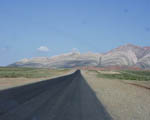
Coloured rocks, northern Argentina
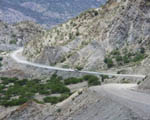
On the Villazón - Potosí section
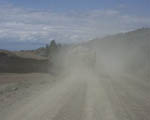
Passing trucks can be hazardous
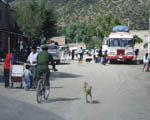
Avenida Panamerica, Cotagaita
 Coloured rocks, northern Argentina |
 On the Villazón - Potosí section |
 Passing trucks can be hazardous |
 Avenida Panamerica, Cotagaita |
Day 18 - Monday 7 February
A day off in Potosí in our comfortable traditional inn, for me to catch up with my paperwork and for Jingers to fettle Mitzi. An easier day has also helped us to acclimatise to the altitude. The participants will also have a light day at this time, with just an simple two and a half hour run to Sucre.
Before I left home, I went to a local medic who specialises in Himalayan treks. He prescribed me a course of Ranitidine tablets, which seem to work well in warding off altitude sickness. Another good remedy, he said, is coca, here served everywhere as a tea.
He also gave me his alarming notes about some of the more serious (and happily, in most cases, rare) conditions that can arise. The commonest of these is HAFE, or High Altitude Flatulent Explosion. His notes say 'Very frequent - no known treatment - no unpleasant effects except for other crew members'. Perhaps Frequent Altitude Related Turbulence Syndrome would produce a more accurate acronym.
We are absolutely delighted with Mitzi's performance to date: rugged, fast, comfortable, quiet, with plenty of space for spares and fuel in the back where they are isolated from the passenger compartment and from prying eyes. She handles extremely well on both asphalt and gravel, riding the potholes and bumps with ease. The turbocharger with intercooler means that the power loss at high altitude is minimal.
We had thought of fitting Proflex shock absorbers, but did not have time; I now think that the standard ones are fully up to the job, with the added bonus that Mitsubishi L-200s are sold in all three countries we have visited to date so replacements are available if necessary. She was not delivered with knobbly tyres, but with Bridgestone road rubber which we also didn't have time to change; but again I now think these are the better item, handling just as well on gravel and better on asphalt (of which there is a great deal).
If she keeps it up and lasts the distance - and I see no reason why she should not - I would not hesitate to recommend this as the ideal 4x4, especially given the low price of diesel fuel here. The fact that she cost me only about £13,000 brand new is an added incentive.
I had local cereal soup and medallions of llama tonight. I suppose we have to try these things once, in the name of research.
Day 19 - Tuesday 8 February
Yesterday I was worried about Potosí, and especially the lack of hotel accommodation. Today, we had a great day, and sorted it.
First call was to drop in at the Town Hall to see if the Mayor would see us. He welcomed us with open arms, and before we left gave us a signed letter of support.
He charged Janet, a pretty girl assistant from his Cultural Department, with the task of showing us round. With her help, we cracked both the hotel and the parking problem - no small matter in this city's narrow crowded streets.
There are no large luxury hotels here, but the city is blessed with a number of small traditional inns of 20 rooms or so. We've stayed the last couple of nights in one, and today inspected half a dozen others. All are simple but clean and comfortable, with private bath and mostly with TV. They will do us nicely.
The local military barracks has a big concrete sports arena, which will take all our cars many times over.
Potosí is deservedly a World Heritage Site. At 13,400 ft, it is also the world's highest city, with the world's highest cathedral and the world's highest commercial airport. It takes your breath away in more ways than one.
The city was founded in 1545 when the Cerro Rico, a conical mountain, was found to contain incredible quantities of silver. There was so much that the boom lasted almost 300 years, and a great city sprang up at its foot. In the 17th century, Potosí's population was greater than London's.
The human price was terrible: according to the usually reliable Lonely Planet guide, between 1545 and 1825, as many as eight million African and Indian slaves died from the appalling conditions underground. Mining for tin continues today, under medieval conditions: the average miner has severe silicosis within seven years.
But the wealth has left a great heritage. Potosí contains over 2,000 listed historic buildings, many fine churches and a superb cathedral. The former Mint (Casa de la Moneda), with its superb art collection, stands comparison with some of Europe's finest palaces. And above the town still towers the pock-marked malign presence of the Cerro Rico. A place I will not easily forget.
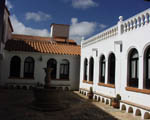
Courtyard of our inn at Potosí |
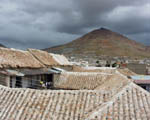
The Cerro Rico 'silver mountain' dominates Potosí's roofs |
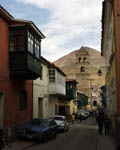
Colonial street, Potosí |
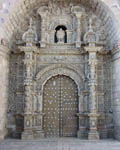
Church doorway, Potosí |
Day 20 - Wednesday 9 February
A short drive to Sucre, along 160 km of excellent modern asphalt which winds its way through superb scenery. We took a detour of 15 km to explore a possible gravel section which started very promisingly with a 5 km climb up the steep side of a valley, but petered out after a while.
A busy afternoon in Sucre with Klaus, head of tourism (and an occasional rally co-driver), who took us round some great little traditional inns. Again, we will have no trouble accommodating the rally.
We were very pleased when Klaus reassured us that some of the rough roads we had encountered, such as 40 km of awful river bed, had been hard hit by this worse than usual rainy season. However, the rains stop in March, the roads are all regraded, and should present no problems to precious classic cars.
Sucre is still the administrative capital of Bolivia. It is a lively city rich in superb historic buildings, including the Casa de la Libertad on the main square, where the treaty ending Spanish rule was signed.
It is also the country's rallying capital. For three days around the national holiday of 25 May, the streets and a loop of local dirt roads are closed for a Belgian-style 'boucles', with the start and finish line in the main square. The cars even jump at one of the crossroads in the centre. A brass plate set into the pavement opposite the Casa de la Libertad marks the traditional start and finish line - it will also be ours.
Tonight I met the President and other senior officials of the local motor club. They showed me that their events are run to the highest professional standards, and I was delighted at the enthusiasm with which they offered support.
Day 21 - Thursday 10 February
A long but spectacular day's drive. We had been advised in Sucre to try a different route from our intended one, as this has suffered badly in the recent rains and is wholly blocked right now. However, the Sucre motor club people have offered to survey it when the dry season comes, and we still hope to use it.
Instead, we drove north out of Sucre on a road that is being rapidly developed as a good asphalt highway, through some outstanding mountain scenery. The word is that the whole length of this 150 km road will be asphalted by October 2001, but this remains to be seen.
The next stretch was remarkable: 145 km of good pavé curling through the mountains. We have created a regularity section along the most interesting 56 km of this. We lunched on delicious local cheese bought from an immaculate small farmhouse. We paused for sobering thought at a monument and a poignant cluster of small memorials to 44 people who died on this road on 31 January 1995, presumably when their bus went over the edge.
The downside of the day was an hour spent negotiating the urban sprawl of Cochabamba and its satellites, but the next stretch of road made up for it: 100 km of truly spectacular main road, winding its way up great mountains with awesome abysses either side, to reach a height of 4,496 metres (14,755 ft). It got dark as we climbed, and the lights of Cochabamba were still visible 88 km after we left the city.
After that, we had a long main road run to arrived at La Paz after midnight. The first view of the city as we started to descend into it was as breathtaking as ever, especially for Jingers who had not seen it before - 'Jingers!', he exclaimed, for probably the tenth time today.
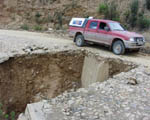
Washaway on the pavé regularity section |
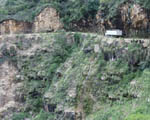
Truck on the ragged ledge during this section |
Next: La Paz to Puno (to be posted Monday 13 March)